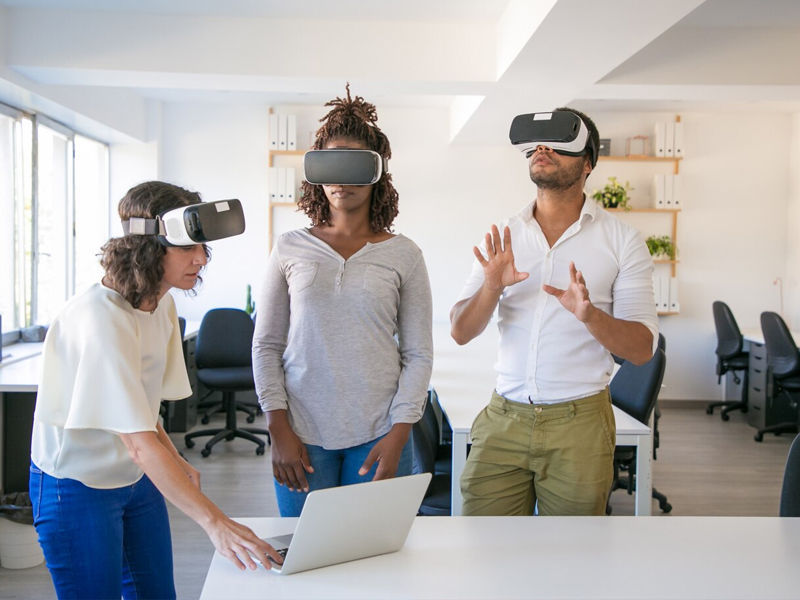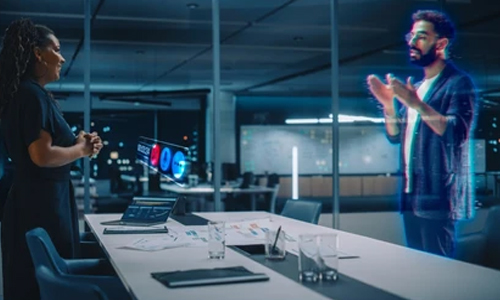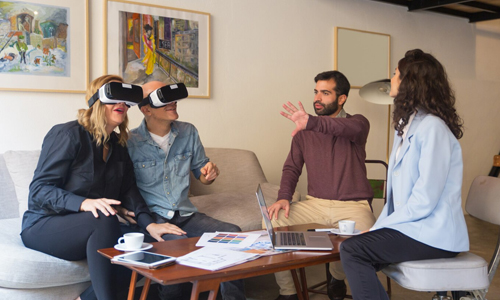From Flat Screens to Shared Spaces: Can AR and VR Breathe New Life into Video Meetings?

AR and VR
Breaking the Flat Screen Barrier
Imagine a world where video meetings feel less like staring at a grid of faces and more like being in a shared workspace. AR and VR offer just that. Here’s how:AR Meetings
 Image Source:Shutterstock
Imagine colleagues appearing as holograms in your physical workspace, allowing you to interact with virtual objects and documents alongside them. AR overlays can enhance presentations with interactive elements, fostering a more engaging experience.
Image Source:Shutterstock
Imagine colleagues appearing as holograms in your physical workspace, allowing you to interact with virtual objects and documents alongside them. AR overlays can enhance presentations with interactive elements, fostering a more engaging experience.
VR Meetings
 Alt text: Video meeting in VR
VR technology can completely immerse you and your colleagues in a virtual environment. Imagine a virtual conference room where you can see and interact with colleagues as avatars, promoting a sense of “presence” and fostering more natural collaboration.
Alt text: Video meeting in VR
VR technology can completely immerse you and your colleagues in a virtual environment. Imagine a virtual conference room where you can see and interact with colleagues as avatars, promoting a sense of “presence” and fostering more natural collaboration.
The Benefits of Spatial Computing
Beyond the novelty factor, AR and VR offer several potential benefits for video meetings:Reduced Fatigue
By breaking away from the limitations of flat screens, AR and VR can alleviate the cognitive strain associated with video meetings, leading to increased focus and engagement.Enhanced Collaboration
Shared virtual spaces allow for more natural forms of communication, including non-verbal cues and body language, which can be lost in traditional video calls.Improved Productivity
AR and VR can enhance collaboration by allowing for real-time interaction with 3D models, whiteboards, and other virtual tools, streamlining workflows and decision-making processes.Increased Creativity
The immersive nature of VR can foster brainstorming sessions and creative problem-solving in ways that are difficult to replicate in traditional video meetings.Challenges and Considerations
While AR and VR offer exciting possibilities, there are challenges to consider:Accessibility
Widespread adoption will depend on the affordability and accessibility of AR and VR headsets, ensuring equitable participation for all team members.Technical Infrastructure
Optimizing network bandwidth and ensuring compatibility across different platforms are crucial for seamless AR/VR meeting experiences.Privacy Concerns
Data security and privacy considerations need to be addressed as we navigate the virtual space and share information in immersive environments.The Road Ahead: A Blended Future
It’s unlikely that AR and VR will completely replace video conferencing in the near future. However, they have the potential to become valuable tools in our remote collaboration toolbox. We might see a hybrid approach, with traditional video calls complemented by AR/VR sessions for brainstorming, design reviews, and presentations requiring deeper collaboration. The future of work is likely to be a blend of physical and virtual spaces. AR and VR can play a pivotal role in creating a more immersive and engaging virtual experience, fostering a sense of connection and collaboration that transcends the limitations of geography. As these technologies evolve and become more accessible, they have the potential to breathe new life into video meetings, transforming them from a source of fatigue into a powerful tool for remote work success. The potential of AR and VR technologies to revolutionize video meetings is addressed here with both the benefits and challenges associated with their integration. This gives a vision of a blended future where AR/VR complements traditional video conferencing, fostering a more engaging and productive remote work experience.You Might Be Interested In:
- Beyond Likes and Followers: Exploring the Evolving Landscape of Social Media
- Is TikTok Facing a US Ban? Decoding the New Law and Its Impact on Millions of Users
- Click, Buy, Pollute? Environmental Impact of Online Shopping and Ways for Sustainable E-commerce
- The High Price of Crypto: Environmental Cost of Mining and Solutions for a Greener Future
Frequently Asked Questions?

01
Cybersecurity
Beyond Likes and Followers: Exploring the Evolving Landscape of Social Media
Apr 28, 2024
01
Tech news
Is TikTok Facing a US Ban? Decoding the New Law and Its Impact on Millions of Users
Apr 27, 2024

01
Tech news
Click, Buy, Pollute? Environmental Impact of Online Shopping and Ways for Sustainable E-commerce
Apr 26, 2024

01
AI & ML
Gemini Evolves: Your AI Assistant on the Go with the New Overlay Feature
Apr 24, 2024
SUSBSCRIBE TO OUR NEWSLETTER
Join our subscribers list to get the latest news and special offers.
Beyond Likes and Followers: Exploring the Evolving Landscape of Social Media
Is TikTok Facing a US Ban? Decoding the New Law and Its Impact on Millions of Users
Click, Buy, Pollute? Environmental Impact of Online Shopping and Ways for Sustainable E-commerce
The High Price of Crypto: Environmental Cost of Mining and Solutions for a Greener Future